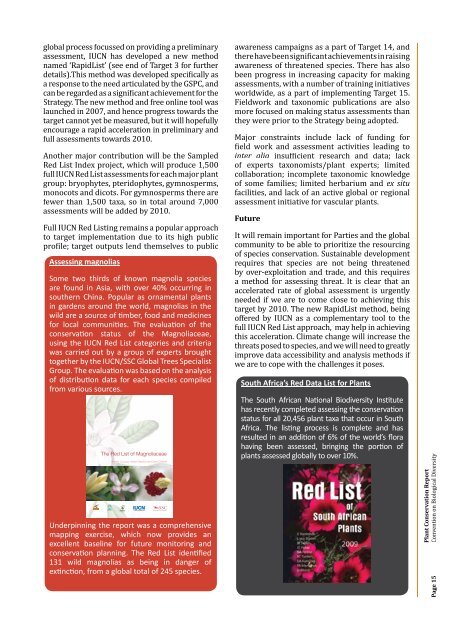from the global partnership for plant conservation
from the global partnership for plant conservation
from the global partnership for plant conservation
Create successful ePaper yourself
Turn your PDF publications into a flip-book with our unique Google optimized e-Paper software.
<strong>global</strong> process focussed on providing a preliminaryassessment, IUCN has developed a new methodnamed ‘RapidList’ (see end of Target 3 <strong>for</strong> fur<strong>the</strong>rdetails).This method was developed speciically asa response to <strong>the</strong> need articulated by <strong>the</strong> GSPC, andcan be regarded as a signiicant achievement <strong>for</strong> <strong>the</strong>Strategy. The new method and free online tool waslaunched in 2007, and hence progress towards <strong>the</strong>target cannot yet be measured, but it will hopefullyencourage a rapid acceleration in preliminary andfull assessments towards 2010.Ano<strong>the</strong>r major contribution will be <strong>the</strong> SampledRed List Index project, which will produce 1,500full IUCN Red List assessments <strong>for</strong> each major <strong>plant</strong>group: bryophytes, pteridophytes, gymnosperms,monocots and dicots. For gymnosperms <strong>the</strong>re arefewer than 1,500 taxa, so in total around 7,000assessments will be added by 2010.Full IUCN Red Listing remains a popular approachto target implementation due to its high publicproile; target outputs lend <strong>the</strong>mselves to publicAssessing magnoliasSome two thirds of known magnolia speciesare found in Asia, with over 40% occurring insou<strong>the</strong>rn China. Popular as ornamental <strong>plant</strong>sin gardens around <strong>the</strong> world, magnolias in <strong>the</strong>wild are a source of timber, food and medicines<strong>for</strong> local communities. The evaluation of <strong>the</strong><strong>conservation</strong> status of <strong>the</strong> Magnoliaceae,using <strong>the</strong> IUCN Red List categories and criteriawas carried out by a group of experts broughttoge<strong>the</strong>r by <strong>the</strong> IUCN/SSC Global Trees SpecialistGroup. The evaluation was based on <strong>the</strong> analysisof distribution data <strong>for</strong> each species compiled<strong>from</strong> various sources.The Red List of MagnoliaceaeDaniele Cicuzza, Adrian Newton and Sara OldfieldUnderpinning <strong>the</strong> report was a comprehensivemapping exercise, which now provides anexcellent baseline <strong>for</strong> future monitoring and<strong>conservation</strong> planning. The Red List identified131 wild magnolias as being in danger ofextinction, <strong>from</strong> a <strong>global</strong> total of 245 species.awareness campaigns as a part of Target 14, and<strong>the</strong>re have been signiicant achievements in raisingawareness of threatened species. There has alsobeen progress in increasing capacity <strong>for</strong> makingassessments, with a number of training initiativesworldwide, as a part of implementing Target 15.Fieldwork and taxonomic publications are alsomore focused on making status assessments than<strong>the</strong>y were prior to <strong>the</strong> Strategy being adopted.Major constraints include lack of funding <strong>for</strong>ield work and assessment activities leading tointer alia insuficient research and data; lackof experts taxonomists/<strong>plant</strong> experts; limitedcollaboration; incomplete taxonomic knowledgeof some families; limited herbarium and ex situfacilities, and lack of an active <strong>global</strong> or regionalassessment initiative <strong>for</strong> vascular <strong>plant</strong>s.FutureIt will remain important <strong>for</strong> Parties and <strong>the</strong> <strong>global</strong>community to be able to prioritize <strong>the</strong> resourcingof species <strong>conservation</strong>. Sustainable developmentrequires that species are not being threatenedby over-exploitation and trade, and this requiresa method <strong>for</strong> assessing threat. It is clear that anaccelerated rate of <strong>global</strong> assessment is urgentlyneeded if we are to come close to achieving thistarget by 2010. The new RapidList method, beingoffered by IUCN as a complementary tool to <strong>the</strong>full IUCN Red List approach, may help in achievingthis acceleration. Climate change will increase <strong>the</strong>threats posed to species, and we will need to greatlyimprove data accessibility and analysis methods ifwe are to cope with <strong>the</strong> challenges it poses.South Africa’s Red Data List <strong>for</strong> PlantsThe South African National Biodiversity Institutehas recently completed assessing <strong>the</strong> <strong>conservation</strong>status <strong>for</strong> all 20,456 <strong>plant</strong> taxa that occur in SouthAfrica. The listing process is complete and hasresulted in an addition of 6% of <strong>the</strong> world’s florahaving been assessed, bringing <strong>the</strong> portion of<strong>plant</strong>s assessed <strong>global</strong>ly to over 10%.Plant Conservation ReportPage 15 Convention on Biological Diversity
















